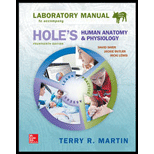
Laboratory Manual for Holes Human Anatomy & Physiology Fetal Pig Version
14th Edition
ISBN: 9781259295645
Author: Terry R. Martin
Publisher: McGraw-Hill Education
expand_more
expand_more
format_list_bulleted
Question
Chapter 26, Problem F26.1A
Summary Introduction
To Identify:
The different parts of the brain in the figure.
Introduction:
The human brain is the anterior-most part of the central neural system, which is embedded in the cranial cavity of the skull.
Expert Solution & Answer
Explanation of Solution
Pictorial Representation: Figure 1 represents the parts of the brain.

Figure 1: Parts of the brain
The different parts of the brain are as follows:
- Cerebrum: The cerebrum is the largest part of the brain, which consists of the right and left hemispheres. It controls higher brain functions.
- Thalamus: It is a small structure that is found above the brain between the cerebral cortex and midbrain.
- Hypothalamus: It is found at the base of the brain whose primary function is to connect the nervous system to the endocrine system.
- Diencephalon: It is a division of forebrain and is found between telencephalon and midbrain.
- Pons: It is the part of the brainstem which controls breathing, communication, and sensations.
- Medulla oblongata: The simple medulla is a long stem-like structure that is responsible for involuntary functions.
- Spinal cord: It is a long tube-like structure that connects the brain to nerves. It consists of grey and white matter like the brain.
- Gyri/convolutions: These are the folds or bumps in the brain. It is the ridge of the cerebral cortex.
- Sulci: These are grooves that separate the brain and increase the surface area of the brain.
- Corpus callosum: It is also known as "callosal commissure," which is a thick band that separates the cerebral lobes into the right and left hemispheres.
- Midbrain: It is composed of tectum and tegmentum. It is an essential area for the control of combined eye and head movements.
- Cerebellum: It stands for "little brain," which is located at the base of the brain.
Conclusion
Hence, Brain is the largest and complex organ that consists of many specialized areas that work together to perform different functions in the human body.
Want to see more full solutions like this?
Subscribe now to access step-by-step solutions to millions of textbook problems written by subject matter experts!
Chapter 26 Solutions
Laboratory Manual for Holes Human Anatomy & Physiology Fetal Pig Version
Knowledge Booster
Recommended textbooks for you
 Human Anatomy & Physiology (11th Edition)BiologyISBN:9780134580999Author:Elaine N. Marieb, Katja N. HoehnPublisher:PEARSON
Human Anatomy & Physiology (11th Edition)BiologyISBN:9780134580999Author:Elaine N. Marieb, Katja N. HoehnPublisher:PEARSON Biology 2eBiologyISBN:9781947172517Author:Matthew Douglas, Jung Choi, Mary Ann ClarkPublisher:OpenStax
Biology 2eBiologyISBN:9781947172517Author:Matthew Douglas, Jung Choi, Mary Ann ClarkPublisher:OpenStax Anatomy & PhysiologyBiologyISBN:9781259398629Author:McKinley, Michael P., O'loughlin, Valerie Dean, Bidle, Theresa StouterPublisher:Mcgraw Hill Education,
Anatomy & PhysiologyBiologyISBN:9781259398629Author:McKinley, Michael P., O'loughlin, Valerie Dean, Bidle, Theresa StouterPublisher:Mcgraw Hill Education, Molecular Biology of the Cell (Sixth Edition)BiologyISBN:9780815344322Author:Bruce Alberts, Alexander D. Johnson, Julian Lewis, David Morgan, Martin Raff, Keith Roberts, Peter WalterPublisher:W. W. Norton & Company
Molecular Biology of the Cell (Sixth Edition)BiologyISBN:9780815344322Author:Bruce Alberts, Alexander D. Johnson, Julian Lewis, David Morgan, Martin Raff, Keith Roberts, Peter WalterPublisher:W. W. Norton & Company Laboratory Manual For Human Anatomy & PhysiologyBiologyISBN:9781260159363Author:Martin, Terry R., Prentice-craver, CynthiaPublisher:McGraw-Hill Publishing Co.
Laboratory Manual For Human Anatomy & PhysiologyBiologyISBN:9781260159363Author:Martin, Terry R., Prentice-craver, CynthiaPublisher:McGraw-Hill Publishing Co. Inquiry Into Life (16th Edition)BiologyISBN:9781260231700Author:Sylvia S. Mader, Michael WindelspechtPublisher:McGraw Hill Education
Inquiry Into Life (16th Edition)BiologyISBN:9781260231700Author:Sylvia S. Mader, Michael WindelspechtPublisher:McGraw Hill Education

Human Anatomy & Physiology (11th Edition)
Biology
ISBN:9780134580999
Author:Elaine N. Marieb, Katja N. Hoehn
Publisher:PEARSON

Biology 2e
Biology
ISBN:9781947172517
Author:Matthew Douglas, Jung Choi, Mary Ann Clark
Publisher:OpenStax

Anatomy & Physiology
Biology
ISBN:9781259398629
Author:McKinley, Michael P., O'loughlin, Valerie Dean, Bidle, Theresa Stouter
Publisher:Mcgraw Hill Education,

Molecular Biology of the Cell (Sixth Edition)
Biology
ISBN:9780815344322
Author:Bruce Alberts, Alexander D. Johnson, Julian Lewis, David Morgan, Martin Raff, Keith Roberts, Peter Walter
Publisher:W. W. Norton & Company

Laboratory Manual For Human Anatomy & Physiology
Biology
ISBN:9781260159363
Author:Martin, Terry R., Prentice-craver, Cynthia
Publisher:McGraw-Hill Publishing Co.

Inquiry Into Life (16th Edition)
Biology
ISBN:9781260231700
Author:Sylvia S. Mader, Michael Windelspecht
Publisher:McGraw Hill Education